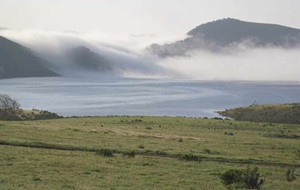The U.S. Supreme Court denied a request from the operators of Twitchell Dam to hear a case regarding water releases from the dam for steelhead trout preservation.
This decision upheld a 9th Circuit District Court of Appeals ruling stating that dam operators—the U.S. Bureau of Reclamation and the Santa Maria Valley Water Conservation District—need to release water for steelhead in order to be in compliance with the federal Endangered Species Act, said Maggie Hall, deputy chief counsel for the Environmental Defense Center, a law firm that represented the Los Padres ForestWatch during the 2019 lawsuit.

“We have known for a long time that Twitchell Dam, located on the Cuyama River, blocks and holds water from getting into the Santa Maria River. Historically, the Santa Maria River had the second largest populations in Santa Barbara County,” Hall said. “Since the dam was constructed in the 1950s, we’ve seen this decline in the steelhead population.”
Steelhead rely on river flows to swim upstream to spawning grounds in the Sisquoc River during the rainy season. By restricting the water that can flow into the Santa Maria, ForestWatch claimed that fish get stranded and aren’t able to access their spawning habitat, Hall said.
“At the district court, the Bureau of Reclamation argued they didn’t have legal authority to make the changes we requested. They argued that they lacked the power to make those changes based on an old law from the creation of Twitchell Dam,” she said. “They said that the law only allowed for them to operate for the purpose of flood control and not to provide for endangered fish.”
The U.S. District Court upheld the bureau’s argument and it was appealed to the 9th Circuit Court of Appeals—which reversed the decision and said the operators need to comply with a “more modern” environmental law that requires agencies to protect endangered species, Hall said.
“The current operations of Twitchell Dam harms Southern California steelhead by impairing their ability to migrate and reproduce,” the 9th Circuit Court ruling read. “The agencies have any discretion to release any amount of water from Twitchell Dam to avoid take of endangered Southern California steelhead.”
The city of Santa Maria, an intervener for the case, filed a petition to the U.S. Supreme Court. Now that the court denied hearing the case, all parties can move forward with setting water release requirements for steelhead, and they have a settlement hearing scheduled for Oct. 13, Hall added.
“The whole goal is to avoid this take to steelhead and give them the flows that will allow them to thrive in this watershed,” she said.
The U.S. Bureau of Reclamation declined to comment, and the Santa Maria Valley Water Conservation District didn’t respond before the Sun’s deadline. Mark van de Kamp, Santa Maria’s public information officer, told the Sun that the city will contribute input to the bureau for a water release plan that will minimize impacts to city water customers.
“The city owns some of the water stored in Twitchell Reservoir. The Bureau of Reclamation owns Twitchell Reservoir, which is operated by the Santa Maria Valley River Water Conservation District,” van de Kamp said in an email. “The next step is for the Bureau of Reclamation to draft the anticipated proposed water release plan.”
Jeff Kuyper, executive director for Los Padres ForestWatch, said that water release for steelhead would need 4 percent of the average annual amount of water stored behind the dam—citing a water report conducted by the state.
“The scientific recommendation is not that the dam needs to release huge volumes of water throughout the year, but looking at when stream flows are happening during storm runoff and can those be supplemented slightly so the steelhead can swim upstream,” Kuyper said.
The bureau is releasing water during the summer months, but trout need the water to swim upstream during the winter, which is the trout’s spawning season, he said.
“The bureau was put on notice and since then, nothing’s changed for years,” Kuyper said. “Steelhead [is] an endangered species and it’s of the essence [we protect them]. We don’t want them to go completely extinct. We had no choice but to file a lawsuit.”









